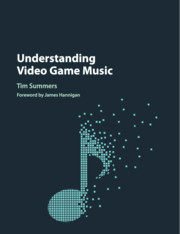Book contents
- Frontmatter
- Dedication
- Contents
- List of Figures, Musical Examples and Tables
- Foreword
- Acknowledgements
- Introduction: Beyond the Candelabrum
- PART I ANALYSING VIDEO GAME MUSIC
- PART II CRITICAL PERSPECTIVES
- 3 Texturing and the Aesthetics of Immersion
- 4 Music and Virtual Game Worlds
- 5 Communication for Play
- 6 Hollywood Film Music and Game Music
- 7 Musical Play and Video Games
- Epilogue: Fun, Play and Music
- Appendix: How to Hear a Video Game: An Outline
- Bibliography
- Ludography
- Index of Games
- General Index
5 - Communication for Play
from PART II - CRITICAL PERSPECTIVES
Published online by Cambridge University Press: 05 September 2016
- Frontmatter
- Dedication
- Contents
- List of Figures, Musical Examples and Tables
- Foreword
- Acknowledgements
- Introduction: Beyond the Candelabrum
- PART I ANALYSING VIDEO GAME MUSIC
- PART II CRITICAL PERSPECTIVES
- 3 Texturing and the Aesthetics of Immersion
- 4 Music and Virtual Game Worlds
- 5 Communication for Play
- 6 Hollywood Film Music and Game Music
- 7 Musical Play and Video Games
- Epilogue: Fun, Play and Music
- Appendix: How to Hear a Video Game: An Outline
- Bibliography
- Ludography
- Index of Games
- General Index
Summary
It is fascinating to watch first-time video game players. These initiates into the gaming world make obvious the learning processes that occur when we become familiar with the rules and conventions of the medium. A few years ago, I had the opportunity to observe one of my close friends undergo this education when he decided to purchase a Wii console. I had not known him to express any particular enthusiasm for video games before, but like many Wii owners, he was attracted by the unusual control interface and the accessibility of the console. One of the very first games in which he became heavily invested was Resident Evil 4 (2007).
As his familiarity with the console, the ‘survival horror’ genre parameters and this particular game grew, he quickly learned how to utilize a certain aspect of the game to help him play – the music. Resident Evil 4 uses a dynamic music engine that alters the music when the player's character is ambushed and attacked by zombie-like adversaries. In the early part of the game, this ‘danger’ music will not cease playing until the threat has been eliminated. My friend, the gaming neophyte, unimpeded by the lack of any formal musical training, recognized how to use the game's music to his advantage. He explicitly vocalized how he knew that he had not neutralized the enemies in a given area, even if order had apparently been restored to the avatar's immediate location, because the ‘danger’ music was still playing. With the possibility of fatal future ambush, he knew to be attentive and to seek out the enemies before continuing. He would frequently explain his process to me (watching his play), making comments to the effect that ‘The music is playing, so there must still be zombies here.’ He improved his game performance and chances of winning through using the information communicated to him by the music.
In the last chapter, we discussed how music is part of the way that the virtual world of the game is constructed for the players. We began to consider how this can inflect the way that the player engages with the game. Pursuing this idea further, in this chapter, we will focus on music that provides gameplay-relevant information which players may use to enhance their chances of winning or achieving a better score.
- Type
- Chapter
- Information
- Understanding Video Game Music , pp. 116 - 142Publisher: Cambridge University PressPrint publication year: 2016



